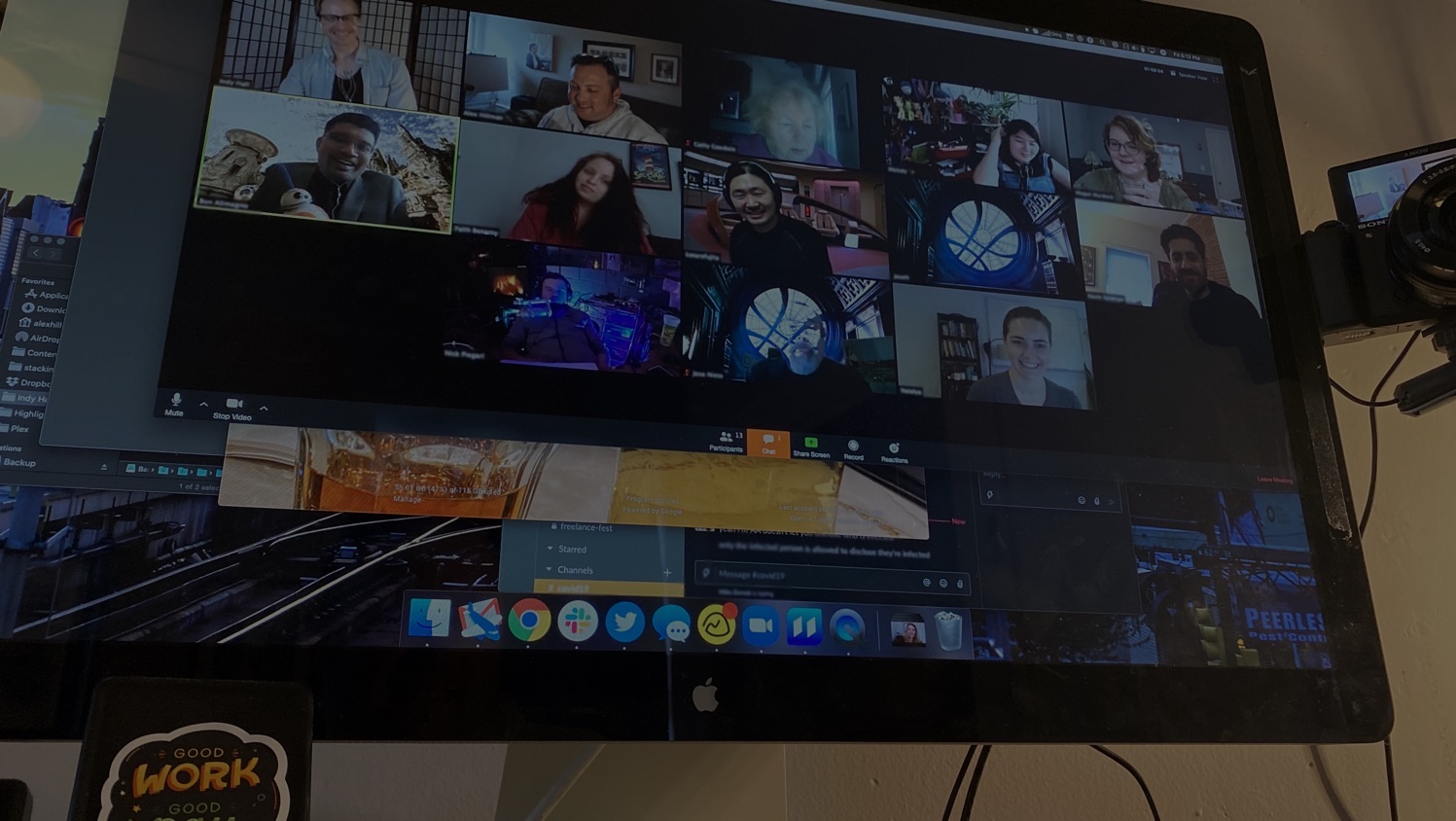The Problem with the Coworking Industry

This year marks 10 years since I discovered coworking and made the decision to build the community that would eventually become Indy Hall.
10 years since I made the decision to stay in Philadelphia and create the community that I so desperately wanted.
10 years since I started something that became so much bigger than just me, beyond what I could have ever imagined.
So it should be no surprise that I’ve been doing a lot of reflecting about Indy Hall itself, and the bigger picture it’s a part of: Coworking.
Reflecting on lessons learned. On friendships forged. On difficult decisions.
I’ve been reflecting on what’s changed, and on what hasn’t changed.
That last thing– what hasn’t changed in the last 10 years of coworking — has been bugging me a lot recently.
Back in 2006 when I discovered coworking it was — as my friend and coworking researcher Jennifer Magnolfi would describe it — an ‘edge phenomenon.’
A few factoids about coworking from my personal memory of the time:
- You could count the number of self-described coworking spaces in the whole world on two hands.
- The people who were participating in coworking spaces were categorically early-adopters. High-tech, web-friendly, geeks.
- Press mentions were scarce†
- There weren’t any established “best practices” — instead, a collection of core values were drafted as guideposts. Keep those core values in line, and best practices likely followed suit.
- And there most certainly wasn’t an “industry” to speak of, let alone conferences or associations.
If I could go back to 2006 and tell myself what was about to unfold, 2006-self would most certainly would tell my time-travling self to shut the hell up and go home.
† True story: I used to have a google alert for the word ‘coworking’ and ‘co-working’ that fed me real-time updates about where coworking was popping up. And I read every article. I had to turn those alerts off sometime in 2010.
I probably sound nostalgic. It wasn’t a better or a worse time, it was a different time. But that isn’t the problem with the coworking industry.
Welcome to 2016. Here, coworking enters its awkward teen-aged years in the mainstream.
Some days, it seems like the world has shifted under our feet, and I think it’s normal for that to feel a little bit weird.
- People are coworking on every continent except for Antarctica (and when the penguins get lonely and want to work together somewhere, I’m sure we’ll head there).
- At last count, more than half a million people around the world are working from coworking spaces. More industries and backgrounds are coworking than I could have ever imagined, far beyond the early-adopter tech crowds of the past. That number grows by a double digit % or more every year.
- The press can’t shut the fuck up about coworking. The changing workplace and workforce is a big topic everywhere, and coworking is a big part of that story. Stories are still dominated by “a new space has opened!” announcements, but thoughtful and well researched pieces have appeared in the New York Times and Harvard Business Review.
- There are mixed opinions on this one, but some people think they’ve operationalized coworking to the point where they can run coworking franchises and chains. McCoworking, so to speak, has arrived.
- For industry education, the Coworking Europe conference is entering it’s 7th year (and now has a spinoff event called The Social Workplace conference. GCUC has replicated to China and South America. Over a dozen total international and regional events in 2016 alone.
Coworking is lauded as revolutionary, innovative, and dozens of other buzzwords that journalists like to use to describe things they think are cool.
Companies of all sizes are scrambling to make their offices look like coworking spaces (and 99% of the time, completely missing the mark).
Corporate real estate has been woken from its slumber for the first time in a couple of decades.
Coworking has become, without a doubt, an industry.
A friend of mine who was a member of Indy Hall in our first few years sent me a text message last week from the Bloomberg/BusinessWeek Design Conference where coworking was a main-stage topic.
She said:
“You know, it’s kinda surreal to see coworking sold to corporate America on the big stage”
I think surreal is a good word to describe it. But I don’t think that’s the problem with the coworking industry, either.
Maybe now more than ever, we need high quality “on-ramp” resources for owners, operators, and staff.
Proof positive: I answer 20–30 emails a week from people seeking help related to coworking.
Questions range from “I’m thinking about XYZ, should I do it?” to “I’ve tried everything and it hasn’t worked. Any suggestions?” to the occasional celebratory “I did what you said and it worked! Thank you!” which is invariably followed with “Now I have a new question…”
These emails fuel my insatiable curiosity and passion for humans. Being able to play even a tiny role in helping people succeed…that’s my oxygen.
And I’m only one of many potential “on-ramps” — a growing number of coworking founders are now offering their experience as consultants, and there are organizations dedicated to improving our shared documentation.
I’m almost (almost) jealous of how many amazing resources exist for coworking space founders today, and the pool gets better all the time.
Momentum is good. Now we need direction.
In most parts of the world, the “oldest” coworking spaces are only 2–3 years old. 5–6 years old would be considered “mature.”
I guess that means I’m basically a coworking dinosaur. As Indy Hall is about to turn 10 years old, we’re actively thinking about what we want to accomplish in the next 10 years. Just saying those words make me glow with pride and excitement. I could do this shit for the rest of my life.
Learning to lead Indy Hall has taught me a lot about the difference between momentum and direction.
- If you know where you want to go, but nobody is moving forward, you’ll never get where you want to go.
- If you say “take 10 steps forward” while everyone is facing different directions, the group scatters further apart instead of collectively towards the goal.
Momentum and direction. You can’t have one without the other.
90% of my job at Indy Hall is to point to our “North Star” — metaphorically speaking — to make sure that the community and team are regularly reminded of where it is and why we’re heading there.
Indy Hall’s North Star guides our conversations and our decisions. Our North Star makes uncertain situations tenable (and steers us towards resolution). Our North Star even drives our business model and improves our profitability.
Our North Star is, and has always been, the people in our community.
When I attend coworking conferences and work with founders and teams around the world, I hear the word “community” everywhere.
But with rare exception, it’s a lot of talking about someone as if they aren’t in the room. It’s a lot of space-side talking heads (myself included) speaking on “their” behalf, whoever “they” happen to be.
So in my reflections on 10 years of coworking, I can’t help but to wonder…
If coworking is truly all about the community, why are our members so notably absent from our coworking industry conversations?
This is the problem with coworking in 2016.
I’m concerned that our dear “coworking industry” seems to be stuck in an infinite loop of coworking space operators talking to coworking space operators about operating coworking spaces.
I get asked a lot if I worry about the big coworking chains pushing out the smaller local operations.
(My answer is no — if us “little guys” stay good at what we do, our biggest competition remains the living room and not another coworking space).
I get asked a lot if I’m worried about cities getting “saturated” with coworking spaces.
(My answer is no — unless you’re offering a commodity product of desks-for-rent. In which case yes, you should very much be worried.)
Coworking used to be a tiny snowball, diligently pushed forward by a passionate community. In 2016, coworking is more like an Indiana Jones-sized boulder rolling downhill, gaining momentum of its own.
At the same time, I’m fairly certain that we’re still near the very bottom of the growth curve for coworking. New spaces open every week. Maybe every day? I’m not even sure any more.
As we continue to climb this curve, it’s clear that conversations among founders and staff are nothing short of transformative.
Very few industries trade information as readily as the coworking industry does. Many people in the world of coworking are unafraid to share their biggest mistakes along with their best practices. Some coworking space founders are even willing to break the sacred vow they took with their accountant to open their books to another aspiring founder.
In case it’s ever been unclear, this is kind of openness and transparency is categorically unusual in the world of business. I’m 100% certain that this being a part of the coworking DNA has played a huge role in why coworking is the phenomenon that it is today.
But too many people in the coworking industry are spending too much time paying attention to what’s happening in the “industry.”
Too much time reading blogs and news articles…and not enough time paying attention to the stuff that matters most.
Too on much focus on “what else is out there” without enough focus on “who is right in front of me.”
I know this next part might sound a little bit counterintuitive, but stick with me. I’m starting to realize that while we’ve been building up such incredible resources between coworking spaces, a lot of people have started to forget that each of us has the most valuable resource right under our nose: our members, our communities.
99 times out of 100, the first step I take to answer any question about coworking comes from answering, “Who is in this community? What do they think? What do they value? What do they care about?”
Once we know those answers, hard answers become a lot easier. Uncertainty and fear start to fall away.
Member voices matter most for the success of coworking. So why are they so rarely a part of the coworking conversation?
There are a whole lot more members than there ever will be operators (and if that’s ever not the case, we have bigger problems to worry about).
We might think it’s because they don’t want to talk shop — and yet, every time I speak to members of coworking spaces I learn more from them than I have from anybody who runs a space. It’s true.
And it’s not just Indy Hall’s own members. I learn more about how other coworking spaces work (and don’t work) from their members and former members than I do from their respective operators.
Imagine if talking shop about coworking was more about how our members experience coworking, from their point of view?
Maybe it’s because “industry” conversations historically don’t include the customer — and yet, coworking is lauded as this innovative, revolutionary force that’s going to shape the future of work.
Yeah, it’s easy to imagine new ways to lay out the office furniture — but the returns on the effort are diminishing.
Meanwhile, it’s challenging to imagine new ways to build relationships with our members (who are also our customers) — but the returns on the effort are enormous.
It’s not just for the good feels, it’s to stay in business. As operators, we have to choose where we put our effort wisely, especially as the ecosystem continues to evolve so rapidly.
I always choose to relentlessly invest more into our our community than anything else.
Always. ALWAYS.

